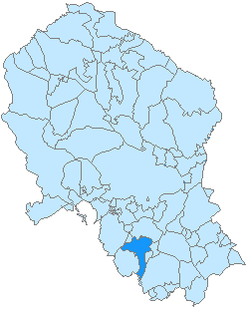Aguilar de la Frontera
Aguilar de la Frontera | |
|---|---|
 | |
 Location of Aguilar de la Frontera in the province of Córdoba. | |
| Country | |
| Municipality | Córdoba |
| Government | |
| • Mayor | Francisco Paniagua Molina |
| Area | |
| • Total | 166.48 km2 (64.28 sq mi) |
| Elevation | 280 m (920 ft) |
| Population (2008) | |
| • Total | 13,692 |
| • Density | 82.24/km2 (213.0/sq mi) |
| Time zone | UTC+1 (CET) |
| • Summer (DST) | UTC+2 (CEST) |
| Postal code | 14920 |
| Website | http://www.aguilardelafrontera.com/ |
Aguilar, or Aguilar de la Frontera, is a municipality and town in the province of Córdoba, Andalusia, southern Spain, near the small river Cabra, 50 kilometers from the provincial capital, Córdoba, on the Córdoba-Málaga railway.
The population has not changed much in the past hundred years, and amounted to 13,653 in 2007[1].
History
First traces of human presence in the area date to the middle Palaeolithic Age. The Romans captured it from the Iberians during the Roman Republic time and named it Ipagro, which took part in the civil war between Julius Ceasar and Pompey, and flourished in the early Imperial Age. After the fall of the Western Roman Empire, it was ruled by the Visigoths and, from the 8th century, by the Muslim emirate of Córdoba, with the name of Bulay (also Pulay).
In the 9th century it became the the headquarters of the rebel Umar ibn Hafsun, who built extensive fortifications and reinforced the castle. However, in 891, Umar ibn Hafsun lost the town to emir Abdallah ibn Muhammad of Córdoba. Due to istr strategical position, it was contented and, after the dissolution of the caliphate of Córdoba, it became part of the cora of Cabra. In 1240 it was conquered by the Christians, although numerous Muslims were allowed to remain. King Peter I of Castile assigned its seigniory to Alfonso Fernandez Coronel, but later reannexed it to the crown. The town was renamed Aguilar of the Frontier due to its position on the border with the Moorish Kingdom of Granada.
In 1370, due to the loyalty shown in the civil war, King Henry II of Castile gave Aguilar to Gonzalo Fernandez de Cordoba, first of a dynasty who held the town until the abolition of feudalism in the 19th century. The town grew until the 1570s-1580s, after which it decayed, also due to several plague outbreaks which decimated the population, and to the shrinking level of the agriculture.
During the Spanish Civil War Aguilar was occupied by the Nationalist faction, which exerted a harsh repression against their adversaries in the city.
Main sights
- Castillo de Ponton, a castle known from at least the 9th century. It is mostly in ruin, a part turned into a cistern for the local aqueduct.
- Casas seňorale ("Noble mansions"), including those of the Montalego, Arrabal and Carrera (16th-17th centuries).
- Torre del Reloy (Clock Tower), in Baroque style, built in 1770-74
- Plaza de San José, a polygonal square from 1806 with the Ajuntamiento (Town Hall).
- Parish Church of Nostra Signora del Sotteraňo, founded in 1260 and remade in 1530
- Church of Seňor de la Salud (17th century)
- Church of the Candeloria (16th century)
- Church of Nuestra S.ra del Carmen (16th century)
- ermita de la Vera Cruz (16th century)
- Hospital of Santa Brigida (16th century)
- convent of San José y San Roque (1671)
- convent of the Carmelitas (1590)
Economy
The olives and white wine of Aguilar are celebrated in Spain, although the wine, which somewhat resembles sherry, is known as Montilla, from the adjacent town of that name. Salt springs exist in the neighborhood, and to the south there are two small lakes, Zoñar and Rincon, which abound in fish.
Up to 60% of the population is engaged in agricultural work at some time during the year, although agriculture accounts for only 30% of the economic activity.[2]
Twin towns
 Verneuil-sur-Seine, France
Verneuil-sur-Seine, France
References
This article incorporates text from a publication now in the public domain: Chisholm, Hugh, ed. (1911). Encyclopædia Britannica (11th ed.). Cambridge University Press. {{cite encyclopedia}}: Missing or empty |title= (help)


